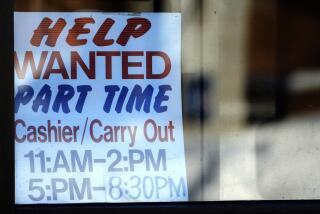Union membership in the U.S. continues its long decline
- Share via
New York — Union membership is continuing to shrink throughout the country, even as companies add jobs in one-time union strongholds such as Michigan.
Union membership fell to 11.3% of wage and salary workers last year, down from 11.8% the year before, the Bureau of Labor Statistics said today. In 1981, 20.1% of wage and salary workers were unionized.
The latest numbers, while not a surprise, are the result of both political maneuvering and corporate negotiations. Both Michigan and Indiana became right-to-work states over the last year, meaning unions cannot require members to pay dues as a condition of employment. In other states, such as Wisconsin, state governments reduced the power of public employee unions.
“This is part of this fight that we’ve been seeing where business and political allies of business are continuing to go after the rights of Americans to join unions,” said William Spriggs, chief economist of the AFL-CIO, after looking at the numbers.
The public sector is the last stronghold of the union movement, which may be why it is a target of conservative leaders eager to cut costs in budget negotiations. About 36% of the public sector is unionized, compared to 6.6% of the private sector.
Membership is much higher for older workers, another bad sign for the labor movement.
Only 10.7% of 25- to 34-year-old workers were unionized last year, compared to 15.4% of workers aged 45 to 54 and 16.4% of workers aged 55 to 64.
Declining unionization may mean the economic recovery proceeds slowly, Spriggs said, because non-unionized jobs typically pay less than unionized ones. Union workers made, on average, $943 a week in 2012, while non-union workers made $742, the BLS said. With lower wages, workers won’t have as much spending power, and businesses that depend on them buying things will see slower sales.
“The problem for America is that we used to think, this is how we’re going to get the middle class,” Spriggs said. “If we’re adding low-wage manufacturing, we’re not getting those middle-class jobs.”
The data comes as Wal-Mart and other companies talk about bringing back to the United States the manufacturing sector, which was traditionally heavily unionized. In a speech last week, Wal-Mart Chief Executive Bill Simon said manufacturers had privately told him there was a “tipping point” when manufacturing overseas would be too expensive, and making things in the United States would be more efficient.
But new manufacturing jobs in the United States usually are not unionized, and traditionally pay much less than traditional manufacturing jobs did. When Suarez Corp. Industries, for example, moved its manufacturing of space heaters from China to North Canton, Ohio, a company executive said employees would make $7.50 to $14 per hour. Former employees in the same facility, which made Hoover products until the plant moved to Mexico, made $20 an hour.
The percentage of workers who were represented by unions in manufacturing fell to 10.5% in 2012, from 11.2% the previous year.
California was one of just a few states that saw union membership grow over the year, part of a drive by car-wash workers, among others, to unionize. About 2.6 million workers were represented by unions in the state last year, about 18.4% of the workforce, up from 2.5 million the year before.
ALSO:
Indiana enacts right-to-work law
IKEA U.S. factory churns out unhappy workers
Right-to-work bills pass in Michigan legislature
More to Read
Inside the business of entertainment
The Wide Shot brings you news, analysis and insights on everything from streaming wars to production — and what it all means for the future.
You may occasionally receive promotional content from the Los Angeles Times.











